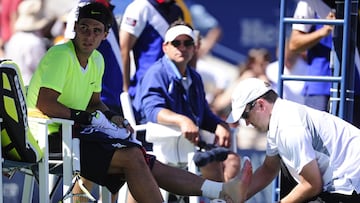What is Müller-Weiss syndrome, Rafa Nadal’s chronic injury in his left foot?
The world number five has been playing with a persistent foot issue for some time and missed the end of last season to receive treatment.

Rafa Nadal is once again into the French Open final, defying his own expectations at his favourite tournament to place himself on the verge of a 14th Roland Garros title when he plays Casper Ruud on Sunday. Nadal is rarely backed to lose on clay, a surface on which he has won over 90% of all the games he has played during his illustrious career, but even the Spanish great has readily acknowledged that every game is potentially his last due to a chronic foot problem that has dogged him for several years.
See also:
Nadal suffers from Müller-Weiss syndrome, which he was diagnosed with in 2005, the same year he won his first French Open. Last year, he was forced to pull out of the US Open and missed the rest of the season to undergo treatment and Nadal himself admits it is a day-to-day process, with the aim of his team and medical advisers being to prolong his career for as long as possible while avoiding surgery. “Honestly, I have been suffering much more than I should with my foot for a year and I need to take some time... to find a solution to this problem or at least improve it in order to continue to have options for the next few years,” Nadal said at the time. However, he returned in style at the beginning of 2022, adding another Australian Open to his Grand Slam collection to take him to 21 overall, one ahead of Roger Federer and Novak Djokovic in the all-time stakes.
Nadal: “We have known for quite a few years that this is incurable”
Speaking to AS and L’Equipe in Melbourne after the tournament, Nadal said: “We have known for quite a few years that this is incurable, so anything that we tried would just be trying to lessen the pain, just enough for me to keep playing. It is the same thing that I have done throughout my career, even though, obviously, everything has a degenerative factor, as logic would dictate.”
Going into the French Open, Nadal was very frank about his foot issue and unsure if he would be able to stand the rigors of a two-week Grand Slam tournament, but once again the Spaniard has played through health issues to reach the final, picking off Djokovic along the way and being spared what was shaping up to be an epic, and potentially a very, very long encounter against Alex Zverev in the semi-finals, after the world number three rolled his ankle in the second set and was forced to leave the stadium on crutches.
Müller-Weiss syndrome explained
Speaking to L’Equipe last September after Nadal announced he would not be playing at Flushing Meadows, Gilbert Versier, the former head of the orthopaedic department at Vincennes military hospital, explained the origins of Muller-Weiss syndrome.
“It usually affects people who have flat feet. It’s congenital. In some people, the arch of the foot is more pronounced - in other words, there is a greater distance between the sole of the foot and the floor. Others have a fallen arch when the insole loses its curvature and those people tend to be more susceptible to this kind of pathology. It causes the navicular bone to become compressed which eventually develops necrosis. Basically, the bone dies, it loses its vascularization,” Versier said.
“A stress fracture could also be the cause - when bones don’t heal properly. When the fracture occurs at the point where vascularization no longer reaches it, the area where the blood vessels are which could result in a necrosis. But it is a very rare pathology, and its origins are not very clear. It’s not a pathology which necessarily evolves very quickly. Deterioration happens over time and is quite painful, but usually osteoarthritis takes a long time to develop. We have seen these kinds of conditions in women over the age of 50. It is not something we tend to see in young people,” he added.






